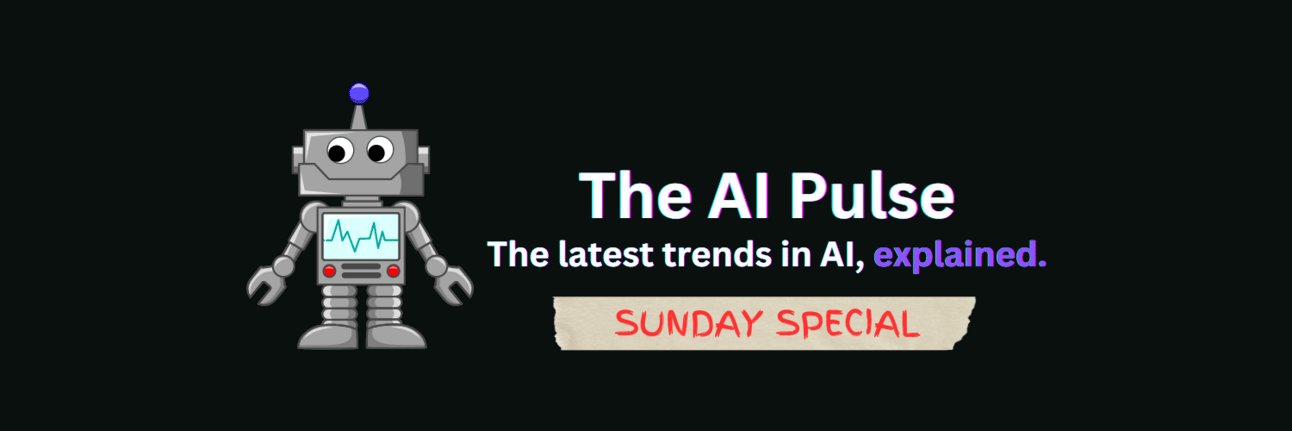
Welcome back AI prodigies!
In today’s Sunday Special:
💥Separating Hype From Reality
📜Roots of Rationality
🔮Modern Manifestations
🦾AI Agent Capabilities
🏁Final Note
Read Time: 8 minutes
🎓Key Terms
OpenAI’s GPTs: tailored versions of ChatGPT for specific tasks, like being a creative writing coach.
Backpropagation: an algorithm that finds errors in an AI model by systematically working back from outputs to inputs.
Application Programming Interface (API): a tool that allows multiple software applications to communicate with each other to exchange data, features, and functionality.
Zero-Shot Prompting: a prompting technique that empowers LLMs to perform tasks they haven’t been explicitly trained for.
💥SEPARATING HYPE FROM REALITY
As AI tools promise larger and larger productivity boosts, many wonder about the feasibility of task automation. AI agent frameworks promise that anyone, even your grandmother, who still uses Internet Explorer, can build an entire app from a single prompt.
Although overpromising isn’t rare in the AI world, not every AI promise gets equal attention. Aside from controversies like Google Gemini’s rollout and new model releases like OpenAI’s GPT-4, few announcements capture the general public’s interest. However, after the release of AutoGPT, AI agents have proven they can also steal the spotlight.
However, unlike OpenAI’s model releases, which typically elicit positive responses, AI agents have a polarizing effect. One group is terrified of AI agents, envisioning a future where terminator-like robots replace workers, while another group wholeheartedly believes AI agents will make them rich by increasing their productivity and spearheading a highly profitable startup. Despite their differences, these two groups tend to overvalue today’s AI agents.
On the other hand, a third group simply ignores AI agents because they don’t see how they differ from chatting with ChatGPT or one of OpenAI’s GPTs. For them, this is all just hype fueled by greedy influencers and even greedier companies. So, who’s right? Let’s find out.
📜ROOTS OF RATIONALITY
At its core, an agent is just a fancy word for anything that can take action, whether it’s a human, an animal, or even a machine. The idea of intelligent agents has been around for centuries, but it’s only recently that we’ve started seeing them everywhere.
The story begins in ancient Greece with Aristotle, who thought the following about what it means to “act” or “achieve” goals: “We deliberate not about ends but about means.” In other words, being rational isn’t about choosing your goals but figuring out the best way to achieve them. This simple idea kicked off centuries of debate about rationality and laid the groundwork for today’s AI agents. Several centuries later, a Persian polymath named Al-Khwarizmi popularized step-by-step problem-solving and became the “father of algebra.” In the 12th century, someone in the West translated his work “On the Calculation with Hindu Numerals” into Latin. Whoever the translator was, they didn’t know what to do with the author’s name and decided to translate “Al-Khwarizmi” as “Algoritmi.” And that’s how the word “algorithm” came to be.
A few centuries later, in 1642, the legendary French mathematician, physicist, and philosopher Blaise Pascal took things to the next level with the world’s first calculator. Suddenly, machines could crunch numbers faster than any human, a crucial step toward intelligent machines. Granted, this machine could only add and subtract, but this was quite impressive at the time.
🔮MODERN MANIFESTATIONS
The 1950s marked the birth of AI as we know it. In 1950, one of the fathers of theoretical computer science, Alan Turing, published a groundbreaking paper that posed a significant question: “Can machines think?” At the time, many denied this possibility. To prove skeptics wrong, Turing proposed “The Turing Test,” where a “Human Interrogator” asks a series of questions through a keyboard and display screen to a “Computer” and “Human Foil.” If the “Computer” consistently fools the “Human Interrogator” into believing it’s the “Human Foil,” it’s considered an intelligent, thinking entity. A few years later, computer scientist and cognitive scientist John McCarthy sought to emulate human thought in machine form, believing he could build a “smart machine” in just two months with ten men.
Right around that time, a new concept called symbolic AI was born. It represented knowledge through abstract symbols and manipulated them according to strict rules and an advanced version of Aristotle’s logic. McCarthy and his colleagues believed that by combining enough of these symbols and rules, they could create machines that could reason, plan, and solve problems just like humans. This approach led to some pretty impressive systems in the 1950s and 1960s, like DENDRAL and MYCIN, which could interpret lab results and identify unknown molecules. Despite its early problem-solving prowess, symbolic AI could not model the messy, complicated world that rarely fits neatly into strict logical rules. Imagine trying to write down every single rule for making a sandwich or having a conversation.
Therefore, in the late 1960s, the field hit a rough patch known as the “first AI winter.” Funding dried up, progress slowed, and individuals started to lose faith in the grand promises of human-like AI. It was clear that symbolic logic alone wasn’t going to cut it. So, researchers developed two key ideas that laid the foundation for today’s advancements:
The Use of Probability: make decisions in contexts of uncertainty.
Machine Learning (ML): statistical algorithms that can learn from data and generalize to unseen data, performing tasks without explicit instructions.
In the 1980s, Bayesian networks hit the scene, allowing AI systems to “reason” about uncertainty using the language of probability. Instead of relying on strict logical rules, these Bayesian networks could learn from data and make educated guesses when faced with incomplete information. Meanwhile, ML algorithms were also making a comeback. A training technique called backpropagation breathed new life into neural networks, allowing them to learn complex patterns from data. This shift towards probabilistic and learning-based approaches changed the game for AI agents. Instead of just reasoning with abstract symbols, AI agents could learn from experience and adapt to new situations, leading to breakthroughs in two key areas of ML:
Reinforcement Learning (RL): teaching AI agents to make intelligent decisions through trial and error, like training a puppy with treats.
Deep Learning (DL): leveraging multiple layers of neural networks to process data, enabling AI agents to tackle complex tasks like image recognition and language processing.
These breakthroughs led to an expanded definition of AI agents beyond reaching a goal, where AI agents create and operate in a digital environment optimized for their performance.
🦾AI AGENT CAPABILITIES
So, what can AI agents do? Today, we’ll focus on AI agents that use Large Language Models (LLMs) as their “brains.” While there are various types of AI agents, such as multimodal and visual AI agents, LLM-based agents stand out due to their unique capabilities.
All LLMs possess varying levels of reflection and common-sense reasoning abilities, with some outperforming others. These crucial capabilities enable LLM agents to make plans, engage in self-reflection, and continuously refine themselves, all stemming from the unique properties of LLMs. Other than LLMs’ intrinsic abilities, there are five other vital characteristics of AI agents:
Autonomous Actions
AI agents can perform tasks independently, making decisions and taking actions without constant human intervention. However, having a human in the loop is ideal to maintain control and guide AI agents towards their objectives.
Memory
Adding memory to an AI agent allows personalization, enabling it to understand and adapt to individual preferences. As preferences evolve throughout our lives, an AI agent with memory can learn and adjust. This adjustment is essential for building long-term relationships between AI agents and users.
Reactivity
To interact with their environment, AI agents must be able to perceive and process the available information. This reactivity enables AI agents to respond to changes, make informed decisions, and provide relevant outputs based on the input they receive. By analyzing and interpreting the data within their environment, AI agents can offer context-aware help.
Proactivity
AI agents are not only capable of planning, writing tasks, and prioritizing, but they can also take proactive steps to accomplish these tasks by searching the Internet, scraping Reddit, or using code interpreters. Currently, this is mainly done through API calls and function calling.
Social Ability
AI agents can collaborate with other AI agents or humans and delegate work. They can “stick to their defined roles in the conversations.” This social ability enables AI agents to work collectively towards common goals, distribute workloads, and maintain coherent communication.
Now, what can AI agents do that humans can’t? The key advantage of AI agents lies in their ability to process information on a massive scale. As AI researcher Stuart Russell puts it, AI systems can do things “not because of their depth of understanding but because of their scale.” And because they incorporate data from multiple places, AI agents can provide any type of output you need: a newsletter with interactive graphics and text, a real-time dashboard, or a restaurant booking.
🏁FINAL NOTE
AI agents perform tasks, whereas chatbots tend to give us information to make decisions. While chatbots can perform functions like summarizing documents or analyzing open-ended user queries, their context is limited to the prompting environment. In contrast, AI agents can operate autonomously across websites, apps, and data types (e.g., text, image, and video). Chatbots enhance marginal productivity, but AI agents eliminate swaths of digital work, empowering us to perform higher-order tasks.
📒FINAL NOTE
If you found this useful, follow us on Twitter or provide honest feedback below. It helps us improve our content.
How was today’s newsletter?
❤️TAIP Review of the Week
“I'm subscribed to a lot of newsletters, but yours is the only one I read consistently. I'm not a techie, but I love learning all things AI.”
REFER & EARN
🎉Your Friends Learn, You Earn!
{{rp_personalized_text}}
Refer 9 friends to enter 🎰May’s $200 Gift Card Giveaway.
Copy and paste this link to others: {{rp_refer_url}}
